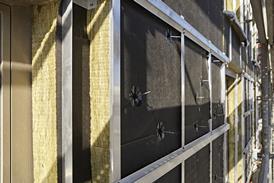I raised concerns passed on to me by several large developers that have become increasingly dissatisfied with the architects’ contracts. The RIBA should be concerned as to the perception of architects created by its standard forms. It gives the impression that architects are more concerned with securing adequate payment, limiting liability and transferring responsibilities away from themselves than with giving a first-class service.
The architectural profession is a respected one and generally architects do a good job. There should be no need for a number of the offensive clauses in the standard contract to remain.
In many commercial relationships, one party secures a limitation of its liability. However, there are very few professions in which the standard contract lays down a limitation of liability as standard. For instance, barristers are not permitted or able to limit their liability in whatever capacity they are acting.
A very good example of the yardstick shifting, which the SFA/99 endorses as standard, is the guarantee that the architect’s work is checked by others. There is nothing wrong with this. The problem is that if there is negligent fault in the architect’s design that was not picked up by another team member, the client is in breach of contract for failing to ensure it was picked up.
Accordingly, given the provisions about contribution, the architect’s 100% liability for the negligent fault is to be reduced by anything up to 50%, to reflect the fact that the client’s other consultants failed to pick up the architect’s negligence. That is not a state of affairs of which architects should be proud.
The contribution arrangements are unsatisfactory. The architect’s liability is to be reduced to reflect other consultants’ and contractors’ contributory responsibilities.
- Liability for architect negligence reduced to 50%
- Client is not able to recover 100% of its losses in court
- “No set-off” clause suggests all clients behave in an unprincipled way
Often, a client’s loss is caused by the fault of more than one party. In law, the client can sue either or both. The client will usually be entitled to recover 100% from either party, with a court reapportioning the loss between them later.
Because the SFA/99 contains an arbitration clause, the parties to the arbitration must be the client and architect. Accordingly, when the client sues the architect in arbitration, it may not recover 100% of the loss due in law from the architect.
Instead, the client has to commence other proceedings against the other people alleged also to have been at fault. But for SFA/99, if the architect were held liable for 100%, it could commence separate proceedings to recover a contribution under the Civil Liability (Contribution) Act 1978. So, SFA/99 prejudices the client.
The inclusion, as a standard term, of the “no set-off” clause assumes that every client will act in an unprincipled way and raise spurious claims of negligence against the architects. There can be no objection to such a term being incorporated on a non-standard basis, but one assumes that the bulk of architects’ clients are perfectly decent.
I accept the point made about the Late Payment of Commercial Debts (Interest) Act 1998 as justifying the application of an 8% penal rate of interest for late payment. Undoubtedly, however, 8% is a penal rate that the courts may ultimately set aside as void. It also creates the impression that it is legitimate to penalise clients.
Having acted successfully for and against architects for 27 years, it is possible for a mere barrister to form comprehensible views about the architects’ standard forms.
Postscript
Robert Akenhead QC is a barrister at Atkin Chambers, London.






















